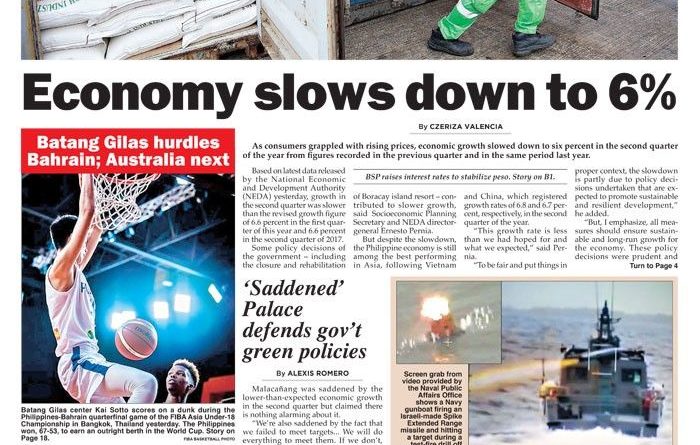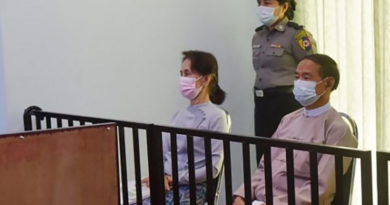ASEANEWS HEADLINE: MANILA – Economy slows down to 6% in second quarter of 2018
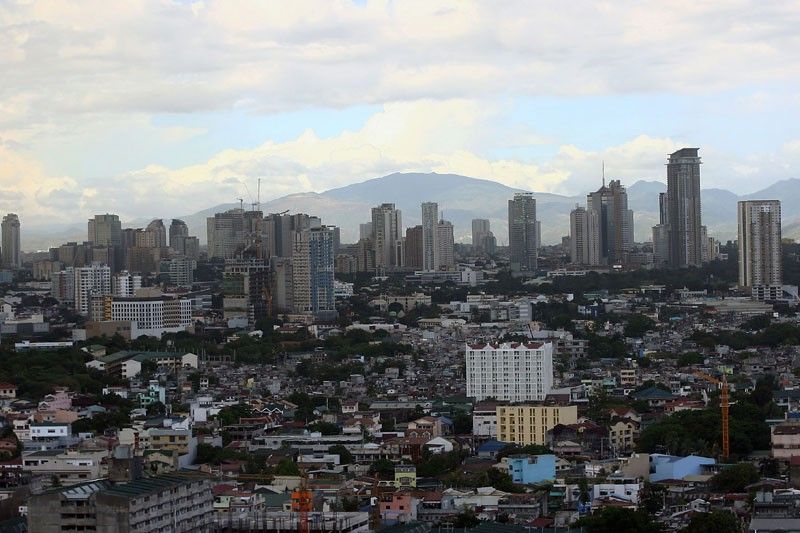

MANILA, Philippines — As consumers grappled with rising prices, economic growth slowed down to six percent in the second quarter of the year from figures recorded in the previous quarter and in the same period last year.
Based on latest data released by the National Economic and Development Authority (NEDA) yesterday, growth in the second quarter was slower than the revised growth figure of 6.6 percent in the first quarter of this year and 6.6 percent in the second quarter of 2017.
Some policy decisions of the government – including the closure and rehabilitation of Boracay island resort – contributed to slower growth, said Socioeconomic Planning Secretary and NEDA director-general Ernesto Pernia.
.
But despite the slowdown, the Philippine economy is still among the best performing in Asia, following Vietnam and China, which registered growth rates of 6.8 and 6.7 percent, respectively, in the second quarter of the year.
“This growth rate is less than we had hoped for and what we expected,” said Pernia.
“To be fair and put things in proper context, the slowdown is partly due to policy decisions undertaken that are expected to promote sustainable and resilient development,” he added.
“But, I emphasize, all measures should ensure sustainable and long-run growth for the economy. These policy decisions were prudent and judicious,” he added.
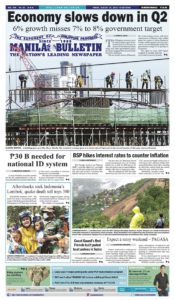
Aside from the temporary closure of Boracay from April to October, the closure of several mining pits and the imposition of excise tax on non-metallic and metallic minerals had contributed to the economic deceleration.
The Boracay closure alone caused the slowdown in the growth of service exports to 9.6 percent in the second quarter from 16.4 percent in the first quarter.
The stricter enforcement of aquaculture regulations in Laguna de Bay also resulted in the drop in freshwater fish catch.
The latest figure has put the average gross domestic product (GDP) growth in the first six months of the year to 6.3 percent, implying the economy would have to expand by at least 7.7 percent in the second semester to reach the low end of the seven to eight percent growth target for 2018.
“We will have to double time to encourage sectors to be more productive and efficient in their activities,” Pernia said at a briefing.
The principal growth drivers of the economy in the second quarter of the year were the manufacturing, trade and construction subsectors. Among major sectors, services recorded the fastest growth at 6.6 percent, followed by industry with 6.3 percent, while agriculture continued to lag behind with a growth of 0.2 percent.
NEDA noted, however, that domestic manufacturing activity softened on the back of strict regulations for controlled chemical and chemical products, coupled with high charges of shipping companies for transporting chemicals.
With the country’s population reaching 106.2 million in the second quarter of 2018, per capita GDP grew by 4.3 percent.
Pernia also noted that inflation continues to put pressure on the economy, particularly on the supply side.

Weak agriculture
The country’s chief economist also noted the persistent weak performance of the agriculture sector.
“We are also gravely concerned about the almost stagnant output of the agriculture sector and this supports our premise that the main reason behind high inflation is the gross deficiency in the domestic production of food, which was not augmented by imported goods, especially rice,” said Pernia.
He noted “dismal” outputs for several agricultural commodities during the second quarter such as palay, corn, sugarcane, copra, livestock and poultry.
Pernia said he is urging the Department of Agriculture to urgently review and reform policies and programs that restrict access to land use, to technology and extension services, as well as to finance and markets.
“This should also include an assessment of the market environment, including the possible presence of cartels and incidence of smuggling,” he said.
NEDA remains optimistic that inflation would moderate by the end of the year in line with the forecast of the Bangko Sentral ng Pilipinas.
Pernia noted that despite price pressures, domestic demand remained strong, growing at a rate of 10 percent, supported by household consumption and investments.
“Higher disposable incomes resulting from the recently passed tax reform package 1 and improved market conditions are seen to help sustain growth,” he said.

Government consumption, however, reported a slight deceleration in the second quarter because of lower disbursements for personnel services, maintenance and operating expenses, as well as subsidies.
Pernia noted, however, that government spending is expected to continue its growth as it works toward the development of human capital through social programs, including cash transfers, the National Health Insurance Program and utilization of the Calamity Fund in disaster areas.
Likewise, the continued implementation of the Build, Build, Build program would give the economy a boost.
Expected to energize the economy in the short term are the entry of the third telco player and the resumption of tourism activities in Boracay by October.
NEDA also urged the immediate approval of the 11th Regular Foreign Investment Negative List, to reduce foreign investment restrictions.
“Together with the proper implementation of the Ease of Doing Business Act, this will surely encourage more investments from both foreign and domestic sources,” said Pernia.
Inflation seen to ease
Meanwhile, the BSP said it expects a significant reduction in inflation with the passage of the rice tariffication bill in Congress, as the staple accounts for about nine percent of the total consumer basket.
BSP Deputy Governor Diwa Guinigundo said the proposed amendments to Republic Act 8178 or the Agricultural Tariffication Act of 1996 – if passed within the third quarter and implemented in the fourth quarter – could reduce inflation by 0.2 percentage points this year.

However, given the dynamics in Congress, Guinigundo said inflation could be reduced by 0.8 percentage points if the tarrification bill is approved before the end of the year and made to take effect early next year.
“It is one of the downside risks to inflation moving forward. So in the baseline scenario, there is no assumption that rice tarrification will come through,” he said.
Inflation leapt to a fresh five-year high of 5.7 percent in July from 5.6 percent in June, bringing the average inflation to 4.5 percent in the first seven months of the year and exceeding the two to four percent target set by the BSP amid higher oil prices, more expensive rice, weak peso and the impact of the tax reform law.
Guinigundo pointed out one of the factors that could temper inflation is the imposition of tariff on rice imports.
The BSP, together with other government agencies including NEDA and the Department of Finance (DOF), have been pushing for the passage of the rice tariffication bill in Congress.
The move is seen as a significant step in reforming the agricultural sector by removing unnecessary government intervention in the rice market.
Once the quantitative restriction is replaced by predictable tariffs, NEDA expects the private sector to respond more effectively to market signals and government can focus on regulating to ensure food safety and fair market competition.
On the other hand, the DOF estimates the removal of the rice quantitative restriction could slash retail prices of rice by as much as P7 per kilo.
Likewise, rice tariffication would help mitigate the impact of the implementation of RA 10963 or the TRAIN law on consumer prices.
Based on its latest assessment, the BSP’s Monetary Board raised its inflation forecast to 4.9 instead of 4.5 percent for this year and to 3.7 instead of 3.3 percent for next year.
The BSP yesterday delivered its biggest rate hike in a decade as it raised interest rates by another 50 basis points to rein in inflation expectations and prevent sustained supply-side pressures from driving further second-round effects.
The central bank has so far raised benchmark rates by 100 basis points, bringing the overnight reverse repurchase rate to four percent. It lifted interest rates by 25 basis points for the first time in more than three years last May 10, followed by another 25 basis points last June 20. – Lawrence Agcaoili / Czeriza Valencia (The Philippine Star) – August 10, 2018 – 12:00am
NEWSSTAND FRONT PAGES:




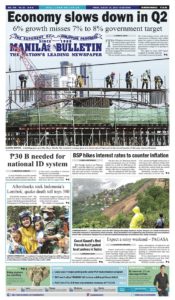


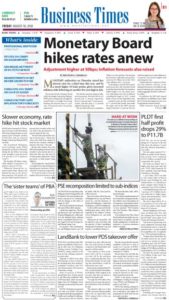



 All photographs, news, editorials, opinions, information, data, others have been taken from the Internet..aseanews.net | [email protected] / For comments, Email to : Aseanews.Net |
All photographs, news, editorials, opinions, information, data, others have been taken from the Internet..aseanews.net | [email protected] / For comments, Email to : Aseanews.Net |

